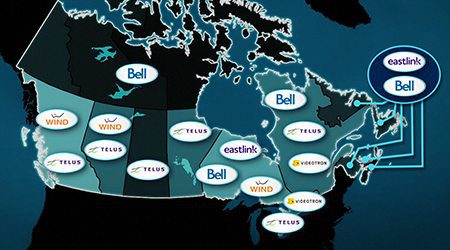Five of 10 qualified bidders picked up spectrum licenses; 2.5 GHz auction next
Canada’s AWS-3 spectrum auction came to a quick end after one day of bidding saw 39 of the 42 licenses up for bid find takers. In total, those 39 licenses generated 2.1 billion Canadian dollars ($1.67 billion) in bids, with five of the 10 qualified participants walking away with licenses in the 1.7/2.1 GHz band.
The auction’s big spender Telus, which accounted for nearly 75% of the auction’s total proceeds in picking up 15 licenses for CA$1.5 billion. Bell Mobility was a distant No. 2, putting down nearly CA$500 million for 13 licenses; followed by Wind Mobile at CA$56.4 million for three licenses; Videotron at CA$31.8 million for four licenses; and Bragg Communications investing CA$10 million for four licenses.
Nationwide operator Rogers Communications, along with qualified bidders Saskatchewan Telecommunications, MTS, TBayTel and Data & Audio-Visual Enterprises Wireless failed to win a license.
The auction included a total of 50 megahertz of spectrum, spread across a 30-megahertz GHI-Block that was set aside for new entrants, and a pair of 10-megahertz J-Block licenses open to all bidders. Telus and Bell picked up all of the J-Block licenses, while Bragg, Videotron and Wind split 11 of the 14 GHI-Block licenses up for bid. Each license will have a lease term of 20 years, with the need to show a level of build-out between 20 and 60%, depending on the license, within eight years.
Canada auctioned off 700 MHz spectrum licenses last year, which raised a record CA$5.27 billion in total proceeds, though came up short in bringing a new nationwide entrant into the space. Verizon Communications had been toying with the idea of entering the auction, before focusing its efforts instead on consolidating its U.S. holdings.
Canada’s AWS-3 auction also came on the heels of a U.S. auction in the same band, which raised a record $44.9 billion in total gross proceeds.
Canada’s telecom regulator Industry Canada put a positive spin on the proceedings, noting that the results continue to feed its move to introduce more competition into the Canadian wireless market, which is dominated by the three nationwide operators. Minister of Industry James Moore noted that prior to the country’s AWS-1 spectrum auction in 2008, the three nationwide operators controlled 98% of the country’s total spectrum allocated to commercial mobile services. Following the scheduled 2.5 GHz spectrum auction set for next month, that amount is expected to be at 75%.
“The auction was a success because the rules were designed to put the interests of Canadian consumers front and center,” Moore said in a statement. “Our government has one goal: to take deliberate, concrete steps to create more choice, lower prices and better wireless service for Canadians and their families.”
A report released last summer by Wall Communications and commissioned annually by Industry Canada and the Canadian Radio-television and Telecommunications Commission, found that pricing for low-end, voice-only wireless rate plans increased 16% year-over-year, while the price of higher-end, data-heavy wireless plans dropped 15% compared with last year’s report. The report noted that “the price of a typical basket of mobile phone services – including voice, text, call display and voice mail features” remained basically the same.
The pricing changes appeared to have been driven by new entrants into the space, with the report finding prices between 10 and 50% less compared with incumbent price plans, with the largest difference seen in unlimited talk, messaging and larger data bucket plans. Those lower prices were also seen in value-branded offerings from incumbent operators, which were priced between 20 and 34% lower than branded plans.
Bored? Why not follow me on Twitter


